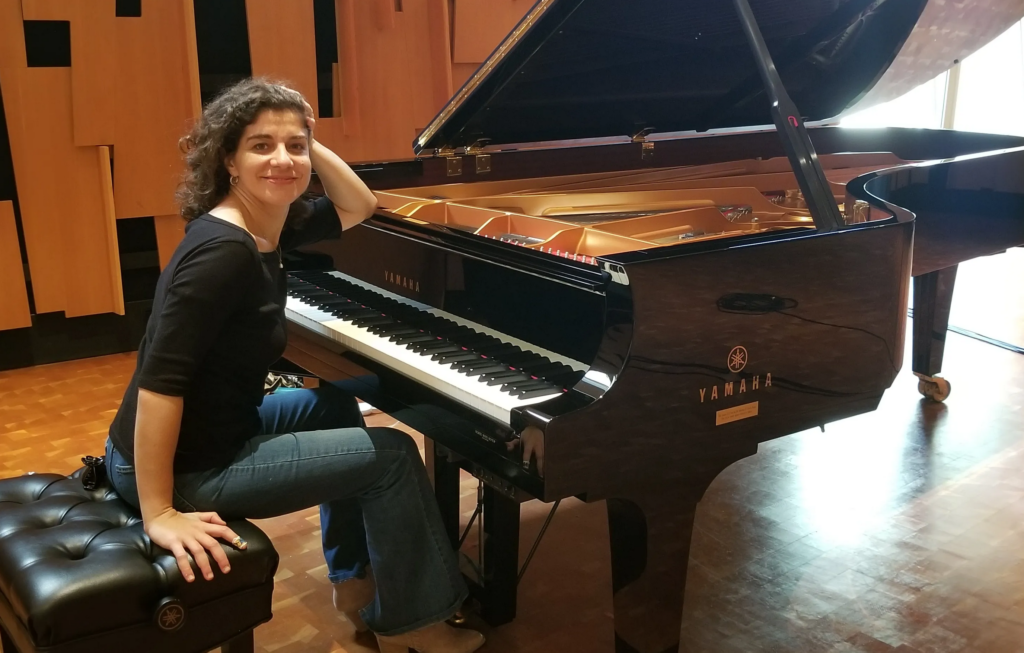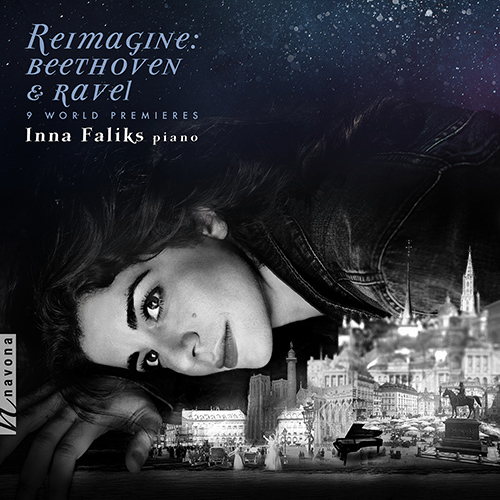Reimagine! – Contemporary Piano Pieces with Inspiration from the Past
Pianist Inna Faliks’ project “Reimagine – Nine World Premieres” includes composers’ responses to Beethoven’s late Op. 126 Bagatelles as well as Maurice Ravel’s Gaspard de la nuit. Piano Street enjoyed her performance at the Cremona Musica and got the opportunity to talk to her about her ambitious project.
At Cremona Musica’s Piano Experience last fall, one half of Ukranian-American pianist Inna Faliks’ project “Reimagine – Nine World Premieres”, was brought to an international audience. This second half called; “Reimagining Gaspard de la nuit” brought more than Faliks’ impressive rendition of the original composition though. We heard three commissioned composers’ reactions on Ravel’s work through their own compositions. Aesthetically, very different in styles.
The whole project, which Faliks has performed worldwide, also includes composers’ responses to Beethoven’s late Op. 126 Bagatelles, and the whole exciting enterprise can be enjoyed on Faliks’ album released for the Navona label in 2021. So, in whole, nine contemporary composers, including Richard Danielpour, Paola Prestini, Billy Childs and Timo Andres, were commissioned to craft responses to Ludwig van Beethoven’s Bagatelles, op. 126 as well as Maurice Ravel’s Gaspard de la nuit. According to critics the results are exhilarating, not least owing to Faliks’ stunningly precise and sensitive pianistic interpretations. Inna Faliks manages to unite three centuries of musical styles and social commentary, as well as producing an album monument not only to the genius of Beethoven and Ravel, but also to the perseverance and verve of some of today’s most exciting and important composers.

Patrick Jovell: Thank you for your lovely performance of Ravel’s Gaspard de la nuit at Cremona Musica. Can you tell me the background of this whole ”re-imagining idea”?
Inna Faliks: The idea was to create a bridge between past and present. The Beethoven Bagatelles Op. 126 are forward looking, experimental, transcendent but also humorous and simple. For me, programming new music is hugely important, and a better way to present it to a larger audience is to invite them to connect to something they already know, and then listen beyond it. So I asked 6 friends, wonderful composers of jazz, film, contemporary classical music etc., to pick a bagatelle and use it as a starting point. My idea was to build this bridge between the past, present and future. I continued by asking 3 of the best known American composers – jazz star and composer Billy Childs, Timo Andres and Paola Prestini – to respond to Gaspard de la nuit, a work I recorded in 2008 on my first commercial record on MSR called Sound of Verse, and one I perform frequently. This work in itself was a response to poetry – so the project becomes almost Meta here. What I got were three significant, large new works for the piano.
PJ: The project has enabled you to work closely with a number of composers. I guess composers in general are more or less familiar with the piano. What can you tell us about these multifaceted and varied personal collaborations?
IF: Each of the collaborations was unique in character. Each of the composers is either a personal friend, colleague or somebody I have known and respected and was interested in working with.
Richard Danielpour is a very frequently programmed and performed composer, and he writes magnificently for the piano. He is my colleague at UCLA – we are close as I was premiering his Bagatelle cycle. The Bagatelle he wrote for me for Reimagine Beethoven and Ravel was actually part of this cycle – and I performed it at the Wallis in Beverly Hills, a prestigious and beautiful Los Angeles theater, alongside with Schumann’s Symphonic Etudes. We became close while I was playing these for him and I am in fact playing another premiere of his; something akin to “Kinderszenen” – this May. I look forward to playing this, and many more works of his. His writing is sensuous, dramatic, technically very effective and demanding but – as very fine piano writing often is – stays very pianistic.
Tamir Hendelman is a jazz pianist and also a good friend – responding to the 2nd Bagatelle for him was fun as it is almost like an improv that spins out. It was a give and take process, definitely – and I am very happy with the energy of this piece.
Mark Carlson’s voice is very tender, heart on the sleeve, very beautiful – and beloved, because it is so sincere. His Bagatelle has received so much responses – it has truly magical colors. So often composers are afraid to write music that is “beautiful” – this piece shows how magical that can be when it truly comes from the soul. I always felt that I can be very very free with this piece, and that’s what made him most happy.
David Lefkowitz is the head of theory at UCLA, and was actually the most demanding in terms of how the piece needs to flow. I really appreciated this – because it is very complex, and haunting.
Peter Golub’s Bagatelle is wonderful as the first piece. It’s quirky and feels to me as though the original Bagatelle is looking into the mirror and seeing something very funky, as though the mirror breaks, or the light shifts. Peter is a film composer, and has very clear moments of action and suspense in his Bagatelle, I think.
Ian Krouse’s piece is the most difficult – it’s really a huge virtuoso showpiece, with an insane fugal section that repeats differently each time, without a pattern, and a transcendent contrasting section, just as in the 4th Bagatelle. This was the hardest piece, physically – its toccata-like intensity and changing patterns require lots of work. Ian was always very gracious – and forgiving, in terms of some very prestissississimo tempi! But I like to take it fast, and the recording succeeds I think.
Now for the Ravel pieces. The most “in-person” collaboration was with my dear friend Billy Childs, because he lives in Los Angeles. That was also the most challenging one. Billy’s piece is truly brilliant, a virtuoso masterwork – and it refers to a Black man running from the police, as it was composed shortly after the George Floyd murder. It will be the first piece in a suite that Billy is writing for me, called “Freedom Suite”. There are sections in the piece that are inspired by Herbie Hancock. I would play it for Billy, and he would always tell me that I am playing those sections “too beautifully”, with a natural rubato, but he wants them as steady and direct and almost “ugly” – so that was a challenge, to find a balance. Billy’s harmonies are incredibly luscious. Ravel is his favorite composer. It’s hard not to make those harmonies sensuous! I just can’t help it sometimes.
Timo Andres’ piece has its own difficulties. It’s a huge minimalist work that grows in intensity. It may not sound like it, but it is hugely challenging because there are no patterns at all. It needs enormous restraint and stamina. Sometimes, I would be tempted to allow a climax to happen way before it needs to, to use more pedal – but it needs restraint.
Paola Prestini’s piece was very natural to play, just so colorful and so fitting to Ondine. We worked out various rhythmic details – the piece is written meticulously, even if it sounds very natural and sometimes almost improvised.
In the Ravel response cycle, each piece really can stand on its own. They are fantastic additions to the piano repertoire, and I am very proud to premiere them and to be the dedicatee for them.
This feature is available for Gold members of pianostreet.com

Play album >>
PJ: Thank you for providing your personal reflections about the works of your collaborators. Such a project states the eternal qualities of art creation mirroring a process how contemporary expression is made possible through reflections and references to the past. In the old days the pianist and composer was the very same person. The modern performer though is trained to interpret only. As a university teacher, how are your thoughts on composition and improvisation for that sake, among young performers heading for a professional career?
IF: First of all, I am a performer through and through, and this is why I have a fresh outlook on teaching. I believe the two things cannot be separated.
Now about improvisation – every performance needs to have an element of improvising, of spontaneity. Imagination, honesty of musicianshiip and music making that comes from the heart are the things, in my view, that distinguish a real artist. In my view, composition and improvisation are an integral part of a musician’s world and should be experienced by every child from the start and be part of tbeir vocabulary. I started out as a composer. At 9, I composed an opera that was performed in Odesa. I had lots of piano music, cello, voice music- I studied composition seriously but then the piano took over. My many projects , I believe, are the way I express that part.
When I performed Rzewski ‘s People United, my favorite part was the long improvisation at the end… and somehow that restarted something. I am beginning to compose again.
I recently revised a few short pieces I carried with me through immigration. They will be a “Ukrainian Childrens Suite”. Also, I may be composing for a project of responses to Schoenberg’s op 11, one of my next things.
Resources:
Comments